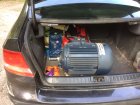The "I need a new lathe" threads which turn up weekly typically involve an announcement or two about rated horse power and "I can stall this 3hp brand X lathe but my 2hp brand Y keeps on chooglin...". The manufacturers seem to take a lot of license on their HP claims. Why? Or better, how do they get away with it?
A few things I remember from high school physics (a long, long time ago):
1. Electrical power is measured in Watts and my be calculated as voltage X current (volts X amps).
2. There are 746 watts per 1 HP
3. 4th law of thermodynamics (very roughly) "You can't get more energy out of a system than what is put in".
4. There are nuanced differences between electric HP and mechanical HP. I am going to ignore this and just fall back on the 4th law of thermo.
A few things learned from the School of Hard Knocks:
5. Manufacturers lie.
6. You never get 100%
7. Stuff is always more complicated than meets the eye.
8. In the USA we have two options on (residential) voltage, 110 VAC and 220 VAC
Given all this, lets generalize.
If a brand claims 3 HP and is 220 VAC, the current rating must be, at least, (3HP X 746W/HP)/220V = 10.17Amps.
I believe most (all?) service tags list both the voltage and the current ratings, so if your lathe is rated at 3HP and plugs into a 220V outlet the amperage rating must be at least 10.17 amperes. And that would be at 100% efficiency which is never achieved.
Given this, how do the manufactures get away claiming a 3HP unit that is really a 2HP unit when the V and A ratings do not line up?
I know I have simplified this and do not address VFD's, induction motors, ... I am just going for the theoretical maximums and relying on the 4th law of thermodynamics in the "at least" restriction to keep things honest. Kind of the physics equivalent of likening a cow to a homogeneous, frictionless sphere.
A few things I remember from high school physics (a long, long time ago):
1. Electrical power is measured in Watts and my be calculated as voltage X current (volts X amps).
2. There are 746 watts per 1 HP
3. 4th law of thermodynamics (very roughly) "You can't get more energy out of a system than what is put in".
4. There are nuanced differences between electric HP and mechanical HP. I am going to ignore this and just fall back on the 4th law of thermo.
A few things learned from the School of Hard Knocks:
5. Manufacturers lie.
6. You never get 100%
7. Stuff is always more complicated than meets the eye.
8. In the USA we have two options on (residential) voltage, 110 VAC and 220 VAC
Given all this, lets generalize.
If a brand claims 3 HP and is 220 VAC, the current rating must be, at least, (3HP X 746W/HP)/220V = 10.17Amps.
I believe most (all?) service tags list both the voltage and the current ratings, so if your lathe is rated at 3HP and plugs into a 220V outlet the amperage rating must be at least 10.17 amperes. And that would be at 100% efficiency which is never achieved.
Given this, how do the manufactures get away claiming a 3HP unit that is really a 2HP unit when the V and A ratings do not line up?
I know I have simplified this and do not address VFD's, induction motors, ... I am just going for the theoretical maximums and relying on the 4th law of thermodynamics in the "at least" restriction to keep things honest. Kind of the physics equivalent of likening a cow to a homogeneous, frictionless sphere.

